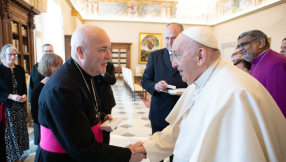New Church figures show attendance 'stable'
The figures show that some 1.2 million people attend a Church of England church or cathedral each week and 1.7 million attend a church or cathedral service each month.
The total number of adults, children and young people regularly attending church has dropped one per cent since 2002.
For every 50 people attending church or cathedrals on a typical Sunday, another nine attend during the week and an extra 36 in total over a month.
The figures reveal, however, a drop in attendance among young people. Between 2006 and 2007, the number of under-16s taking part in a service fell by four per cent.
The Rev Janina Ainsworth, Chief Education Officer for the Church of England, commented that the Church was still very involved with young people despite the fall in the number of young people attending service.
“The Church has a wide range of links with children and young people, through uniformed groups, informal clubs and activity groups, and not least the one million children in Church of England schools. Many of these young people will be involved in some of the wide range of creative events planned by parishes and dioceses to celebrate the Year of the Child 2009,” she said.
The number of baptisms has risen, meanwhile, among adults and among children between the ages of one and 12, with the rate of baptisms of children under 12-years-old at its highest level since 2002.
The number of marriages taking place in church also increased slightly to 54,600, while the total number of funerals fell by two per cent.
The Rev Lynda Barley, Head of Research and Statistics for the Archbishops’ Council, said the figures reinforced the pattern of attendance at church services outside Sundays which, she said, were adding “significant” numbers to local congregations.
More than half of the dioceses from the north-west to east and south-east of England are showing signs of growth, she added.
“Taken as a whole, these figures show that over the past few years the Church has maintained stable numbers of regular worshippers while we are also continuing to explore creative ways of responding to the spiritual needs and lifestyles of those they serve – such as the 37,000 who returned to church on Back to Church Sunday 2008,” said Rev Barley.
“There are some encouraging signs in the ways the Church helps people mark important occasions in their life. We also know that there is significant expansion going on ‘under the radar’ in less traditional activities in which churches are engaged, such as the thousands of ‘fresh expressions’ initiatives, where the Church is seeking new ways of responding to the nation’s spiritual thirst.”
The figures revealed fluctuations in the number of people attending services at Christmas. As in other years when Christmas Day fell on a weekday, attendance over Christmas Eve and Christmas Day in 2007 saw a considerable drop of 11 per cent on 2006 figures. Carol and Christingle services, meanwhile, continue to grow in popularity.
The Rt Rev Graeme Knowles, Dean of St Paul’s, comments: “It seems that as a general trend, when Christmas Eve falls on a Saturday or Sunday we see considerable increases in attendance at church services. When it falls midweek, attendances appear to be dispersed to other services and events during Advent, such as carol or crib services.
“Perhaps it is something to do with people wanting to go to a church they know well, but when people are more likely to travel away from home or where they take extended leave during Christmas because of the way that their statutory holidays fall, we do see an impact on church attendance.”













